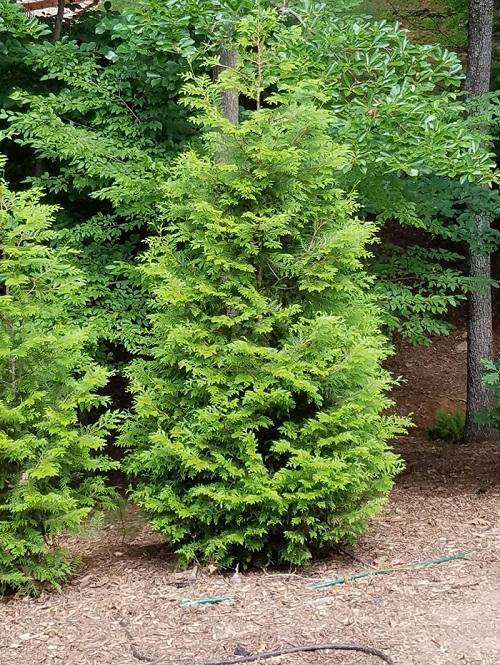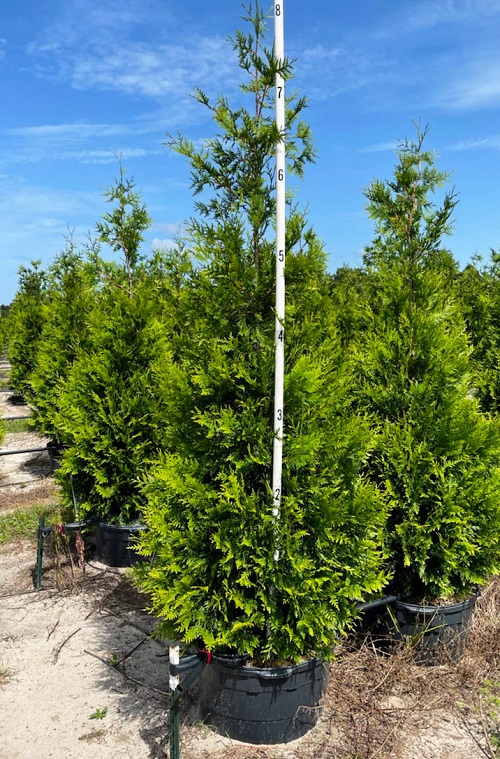Read our article on Green Giant Arborvitae Growing Information and learn all about this popular evergreen tree.
Green Giant Arborvitae, also known as Thuja Green Giant, is a popular evergreen tree that is widely planted in residential and commercial landscapes. This tree is highly valued for its fast growth rate, dense foliage, and tolerance to a wide range of soil and environmental conditions.
Botanical Name: Thuja standishii x plicata ‘Green Giant’
USDA Zones: 5-8
Check out some amazing tall grass for privacy ideas here
Green Giant Arborvitae Plant Information
Green Giant Arborvitae is a hybrid cultivar that was first introduced in the United States in the late 1960s. It is a cross between two species of trees, the Japanese Arborvitae (Thuja standishii) and the Western Red Cedar (Thuja plicata).
This plant was first developed by a nurseryman named Robert D. Raugh in Pennsylvania, USA. He hybridized the two species and selected seedlings with the best traits, including fast growth, disease resistance, and adaptability to various growing conditions.
The Green Giant Arborvitae quickly gained popularity due to its many desirable characteristics. It is now widely cultivated throughout the United States and other parts of the world, including Europe and Asia.
Green Giant Arborvitae is highly adaptable to various growing conditions and can thrive in full sun to partial shade. It prefers well-drained soils but can tolerate a wide range of soil types, including clay, loam, and sandy soils. The tree is tolerant of drought, heat, cold, and wind, making it an ideal choice for various climates.
Propagating Green Giant Arborvitae
Green Giant Arborvitae can be propagated by several methods, including cuttings and seed.
- Cuttings: Cuttings are a popular way to propagate Green Giant Arborvitae. Softwood cuttings are taken from the tips of new growth in late spring or early summer. The cuttings should be about 4-6 inches long and include several pairs of leaves. Dip the cuttings in rooting hormone and plant them in a container filled with a well-draining soil mixture. Keep the soil moist and the container in a warm, bright location out of direct sunlight. Roots should develop in about 6 to 8 weeks.
- Seed: Green Giant Arborvitae can also be propagated from seed, although this method is less common due to the slow growth rate of the tree. Collect mature cones from the tree in the fall and dry them in a warm, well-ventilated location. Once the cones have opened, remove the seeds and store them in a cool, dry location. Plant the seeds in the spring in a container filled with a well-draining soil mixture. Keep the soil moist and the container in a warm, bright location out of direct sunlight. Germination can take several weeks to several months.
Growing Requirements of Green Giant Arborvitae
Light
The Green Giant Arborvitae requires full sun to partial shade to thrive. It needs at least 5-6 hours of direct sunlight per day but can tolerate some shade, especially in hot climates.
Providing adequate sunlight promotes healthy growth and development of the tree.
Soil
It prefers well-draining soil that is slightly acidic to neutral, with a pH range of 6.0 to 7.5. The soil should be moist but not waterlogged, as overly wet soil can lead to root rot.
Amending the soil with organic matter, such as compost or peat moss, can help improve soil drainage and nutrient availability.
Water
The Green Giant Arborvitae requires regular watering, especially during its first year of growth. It prefers evenly moist soil, but be careful not to overwater as it can lead to root rot – water only when the topsoil feels a little dry to the touch.
Once established, the tree can tolerate some drought but will benefit from occasional deep watering during extended dry periods.
Temperature
The plant prefers cool to moderate temperatures. The ideal temperature range for this tree is between 60-90 degrees Fahrenheit (15-32 Degrees Celsius).
In terms of cold temperatures, Green Giant Arborvitae is highly cold hardy and can tolerate temperatures as low as -40°F (-40°C). This makes it an excellent choice for gardeners in colder climates who are looking for a fast-growing, low-maintenance evergreen tree.
Green Giant Arborvitae Care

Fertilizer
Feed Green Giant Arborvitae in early spring before new growth begins. Avoid fertilizing during the hot summer months or late fall.
Use a slow-release, balanced fertilizer with a nitrogen-phosphorus-potassium (NPK) ratio of 10-10-10 or 16-4-8. Avoid fertilizers high in nitrogen, which can promote excessive growth and make the tree more susceptible to winter damage.
Apply the fertilizer according to the manufacturer’s instructions, taking care not to over-fertilize. Generally, you should use approximately 1 pound (0.45 kg) of fertilizer per 100 square feet (9.3 square meters) of soil.
Pruning
The Green Giant Arborvitae tree generally requires little pruning, but it may benefit from some light shaping or maintenance pruning. Pruning should be done in late winter or early spring before new growth begins.
Remove any dead, diseased, or damaged branches, and thin out any crowded or crossing branches to promote healthy growth and a desirable shape.
Pests and Diseases
The tree is relatively pest-resistant, but it may be susceptible to some common pests, such as bagworms, spider mites, and scale insects. Regular inspection of the tree and prompt treatment with an appropriate insecticide can help to control pest infestations.
It is also relatively disease-resistant, but it may be susceptible to canker, root rot, and blight. Maintain good soil drainage, avoid over-watering, and prune timely to prevent these issues.
Learn about the most common garden pests here
Landscaping with Green Giant Arborvitae
Here are some ideas for using Green Giant Arborvitae in landscaping:
- Privacy screen: Green Giant Arborvitae is an excellent choice for creating a privacy screen in your yard. The tree’s dense foliage provides year-round coverage, and it can grow up to 60 feet (18 meters) tall and 20 feet (6 meters) wide. Plant them in a row to create a living fence or use them to block unsightly views.
- Windbreak: Due to its dense foliage and sturdy branches, Green Giant Arborvitae is also a great choice for creating a windbreak in windy areas. Plant them in a row on the windward side of your property to protect your home and garden from strong winds.
- Hedge: Green Giant Arborvitae can be used to create a formal hedge in your landscape design. Prune them regularly to maintain the desired height and shape.
- Accent Tree: Use Green Giant Arborvitae as a focal point in your garden by planting a single tree in a prominent location. Its attractive, pyramidal shape and lush foliage will draw everyone’s attention to your landscape.
- Container Planting: If you don’t have room for a full-sized Green Giant Arborvitae in your yard, consider planting one in a large container. This will allow you to enjoy the tree’s beauty and benefits in a smaller space, such as a patio or balcony.





